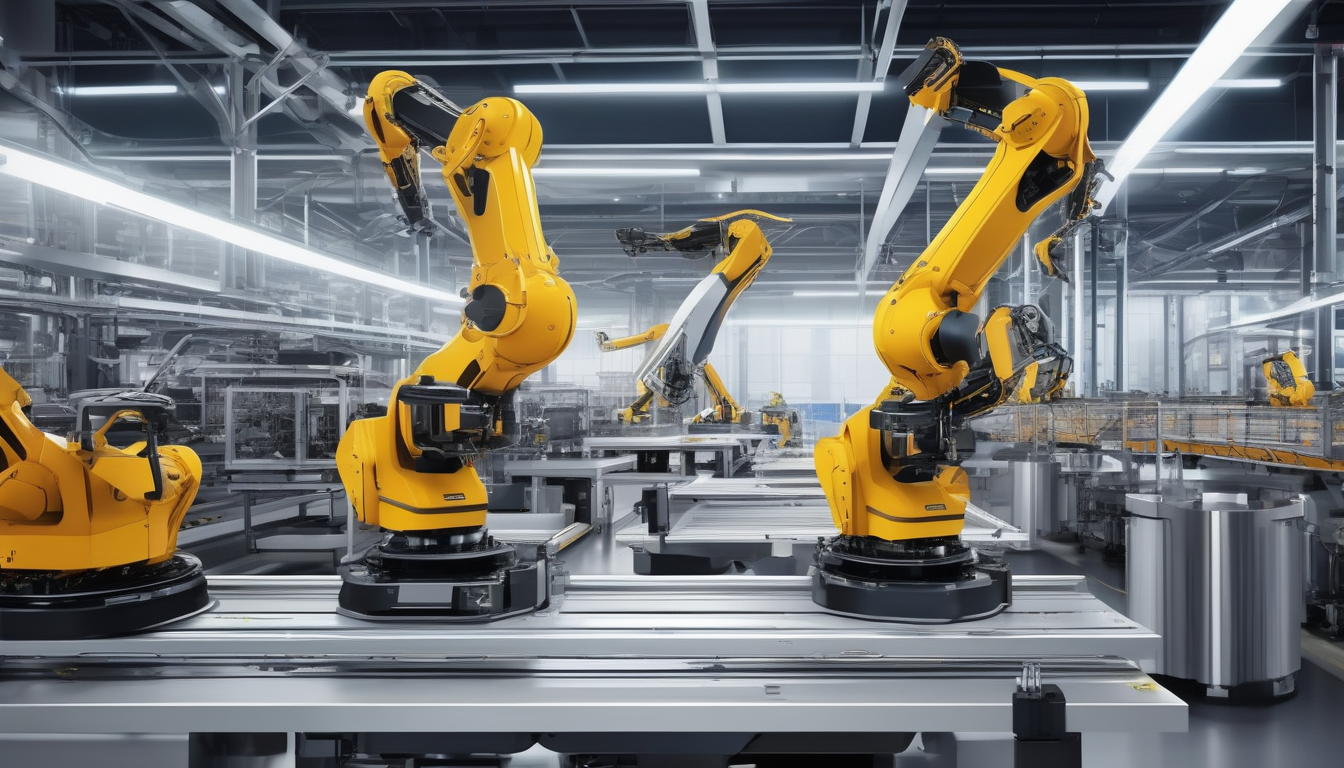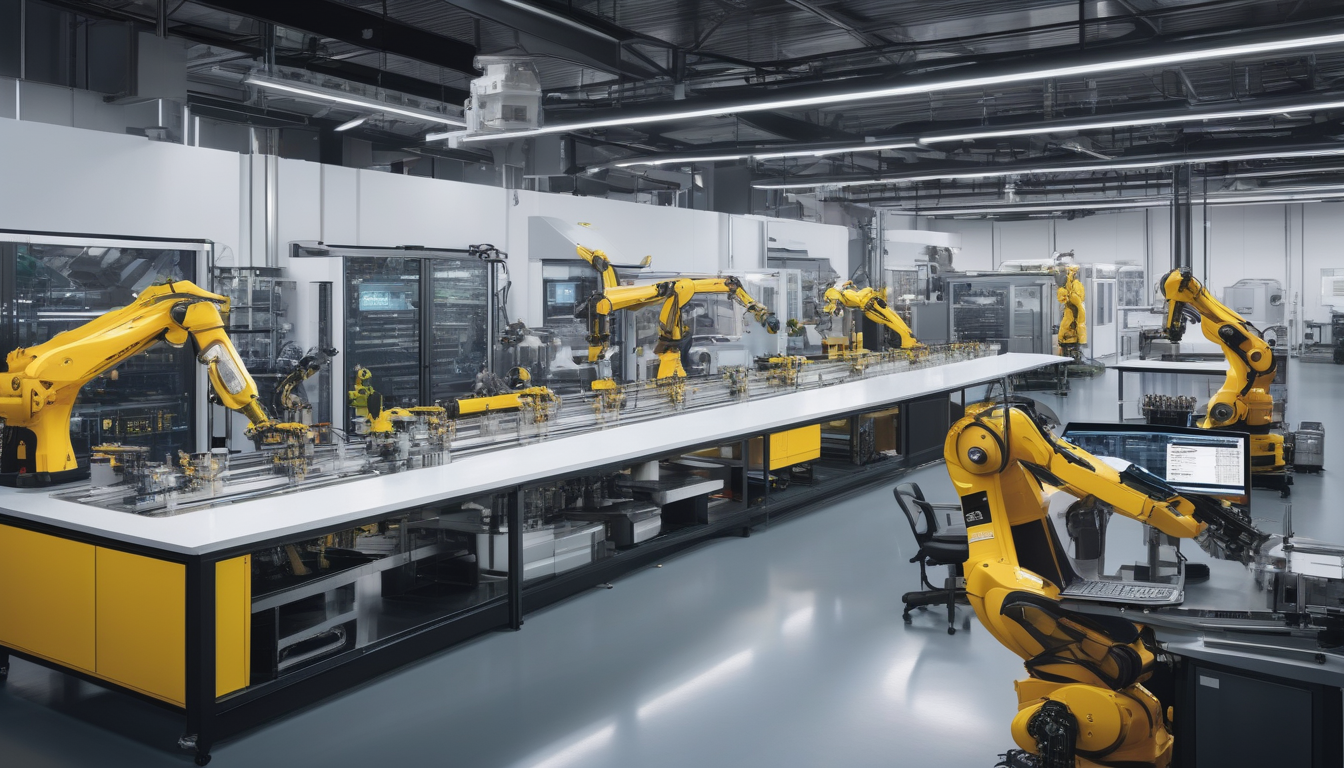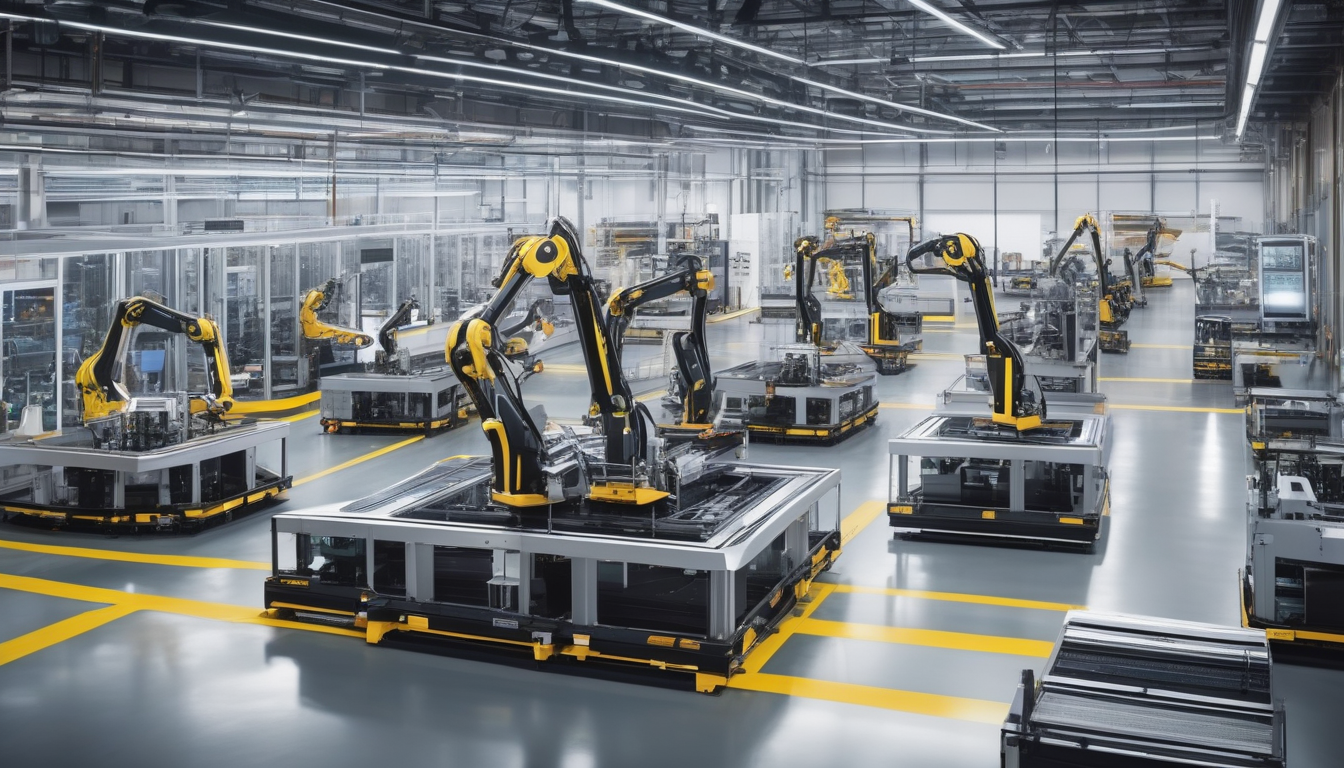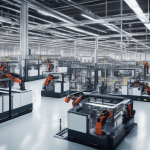The Growing Role of Automation in the Workforce

Automation is not just a buzzword; it’s a revolution reshaping our workplaces and redefining how we view employment. As we plunge deeper into the digital age, the integration of automation technologies is becoming more prevalent across various industries. From manufacturing to healthcare, automation is streamlining processes, enhancing productivity, and even transforming the way we think about our jobs. But what does this mean for the average worker? Are we looking at a future filled with opportunities, or are we facing a wave of job displacement?
The truth is, automation is a double-edged sword. On one hand, it can lead to increased efficiency and lower operational costs, making businesses more competitive. On the other hand, it raises significant concerns about job security. As machines and algorithms take over repetitive tasks, many fear that their roles will become obsolete. This article aims to explore the intricate dance between automation and employment, shedding light on both the challenges and opportunities that lie ahead.
As we navigate through this evolving landscape, it’s essential to recognize the key technologies driving this change. Innovations such as artificial intelligence, robotics, and machine learning are at the forefront, enabling businesses to automate tasks that were once thought to require human touch. Have you ever wondered how a simple chatbot can handle customer inquiries? Or how automated assembly lines can produce goods at lightning speed? These advancements are not just enhancing productivity; they are reshaping entire industries.
But let’s not forget the human element in this equation. The workforce must adapt to these changes, and that means reskilling and upskilling are more crucial than ever. As we delve deeper into this article, we will examine the sectors most affected by automation, the emerging job roles that are being created, and how we can prepare for a future where automation and human labor coexist harmoniously.
So, buckle up as we explore the growing role of automation in the workforce, where the future is not just about machines replacing humans, but rather about how we can leverage technology to enhance our capabilities and create a more efficient working environment.

The Rise of Automation Technologies
Automation technologies have been on a meteoric rise, revolutionizing how industries operate and reshaping the workforce landscape. With advancements in artificial intelligence, machine learning, and robotics, businesses are now equipped to enhance efficiency and reduce operational costs like never before. Imagine a factory where robots work alongside humans, tirelessly assembling products with precision and speed—this is not a scene from a sci-fi movie; it’s the reality of modern manufacturing.
At the heart of this transformation are several key technologies driving the shift towards automation:
- Robotic Process Automation (RPA): This technology automates repetitive tasks that were once performed by humans, such as data entry and transaction processing, allowing employees to focus on more strategic activities.
- Artificial Intelligence (AI): AI systems can analyze vast amounts of data, learn from it, and make decisions, which enhances problem-solving capabilities across various sectors.
- Internet of Things (IoT): IoT devices collect and share data in real-time, enabling smarter decision-making and optimizing operations.
These technologies are not just enhancing productivity; they’re also paving the way for innovative solutions that can address complex challenges. For instance, in agriculture, automated systems can monitor crop health and optimize irrigation, leading to better yields and resource management. In healthcare, automation is streamlining patient diagnostics and treatment plans, ultimately improving patient outcomes.
However, as we embrace these advancements, it’s essential to recognize the implications they carry. While automation presents incredible opportunities, it also poses challenges that industries must navigate carefully. The balance between leveraging technology for efficiency and ensuring a sustainable workforce is crucial. Companies must not only invest in automation but also in their people, preparing them for the future with the right skills and training.
In summary, the rise of automation technologies is a double-edged sword, offering tremendous potential for growth while also necessitating a thoughtful approach to workforce management. As we continue to explore these advancements, one thing is clear: the future of work will be shaped by how well we adapt to these changes.

Impact on Employment
The rise of automation is reshaping the employment landscape in ways we couldn’t have imagined just a few years ago. With machines and software taking over tasks that were once the sole domain of human workers, the implications for job security and workforce dynamics are profound. Are we headed towards a future where robots do all the work, leaving humans out in the cold? Not necessarily. While it’s true that automation brings about job displacement, it also opens the door to new opportunities.
As we dive deeper into the impact of automation on employment, it’s vital to recognize the dual nature of this transformation. On one hand, certain job categories are at risk, particularly those that involve repetitive tasks. Industries such as manufacturing, retail, and even some service sectors are feeling the heat. According to recent studies, it’s estimated that up to 20 million manufacturing jobs could be displaced by automation by 2030. This statistic is enough to send shivers down the spine of many workers.
Yet, it’s not all doom and gloom. The same technologies that threaten existing jobs are also creating new ones. For instance, the demand for roles in data analysis, AI development, and cybersecurity is skyrocketing. As companies adopt more sophisticated automation tools, they require skilled workers to manage and optimize these systems. The key takeaway here is that while some jobs may vanish, new roles will emerge, necessitating a shift in skills and training.
It’s understandable that workers are anxious about job security in the face of automation. The fear of being replaced by a machine is palpable. However, it’s crucial to identify the sectors most vulnerable to these changes. For example, jobs that involve routine tasks, such as assembly line work or cashier positions, are particularly susceptible. Conversely, roles that require creativity, emotional intelligence, and complex problem-solving are less likely to be automated.
Let’s take a closer look at the industries facing the greatest threats:
| Industry | Estimated Job Losses |
|---|---|
| Manufacturing | 4.5 million |
| Retail | 1.5 million |
| Transportation | 3 million |
These numbers highlight the urgent need for proactive measures to address job displacement. Reskilling and upskilling initiatives will play a critical role in helping workers transition into new roles. By investing in training programs, companies can not only mitigate the impact of automation but also foster a more adaptable workforce.
Job Displacement Concerns
The rapid rise of automation technologies has sparked significant concerns about job displacement across various sectors. Workers are understandably anxious, as the thought of machines taking over their roles can feel like a looming shadow. But what does this really mean for the workforce?
As we delve deeper into this issue, it’s essential to understand which industries are most vulnerable. For instance, the manufacturing and retail sectors are often cited as being at the highest risk. In manufacturing, robots can perform repetitive tasks with precision and speed, while in retail, self-checkout systems are becoming the norm. This shift raises a pressing question: how many jobs are actually at stake?
| Industry | Estimated Job Losses by 2030 |
|---|---|
| Manufacturing | 1.5 million |
| Retail | 900,000 |
| Transportation | 3 million |
According to various studies, millions of jobs could be lost in the coming years. However, it’s not just about the numbers; it’s about the people behind those numbers. Each statistic represents an individual with dreams, families, and responsibilities. This stark reality compels us to consider the broader implications for our society.
Moreover, the fear of job displacement often leads to a sense of urgency among workers to adapt and evolve. This brings us to the crucial topic of reskilling and upskilling. As automation becomes more integrated into our daily lives, the ability to learn new skills will be paramount. Workers must embrace continuous education and training programs to stay relevant in an ever-changing job market.
In conclusion, while the concerns surrounding job displacement due to automation are valid and pressing, they also present a unique opportunity for growth and adaptation. By recognizing the challenges and preparing for them, we can transform this potential crisis into a chance for innovation and new career paths.
Industries Most Affected
The wave of automation is crashing down on various sectors, reshaping the employment landscape in ways we never imagined. While some industries are riding the wave, others are struggling to stay afloat. Manufacturing and retail are two sectors that have been hit particularly hard by automation technologies. In manufacturing, robots and automated systems are taking over repetitive tasks, leading to a significant reduction in the need for human labor. According to a recent study, it is estimated that up to 20 million manufacturing jobs could be displaced by automation by 2030. This is not just a statistic; it represents real people facing uncertain futures.
In the retail sector, the rise of e-commerce and automated checkout systems has changed the game. Traditional brick-and-mortar stores are closing at an alarming rate, with many unable to compete with online giants that utilize sophisticated algorithms and robotic processes to streamline operations. For instance, Amazon’s use of automated warehouses has set a precedent that other retailers are struggling to keep up with. This shift has led to the closure of numerous stores, affecting thousands of jobs.
However, it’s not just manufacturing and retail that are feeling the heat. Transportation is also on the brink of a major transformation. The advent of self-driving vehicles could potentially displace millions of jobs in trucking and delivery services. The implications are staggering, as the workforce must prepare for a future where human drivers may become obsolete.
To better illustrate the impact of automation across these industries, consider the following table:
| Industry | Estimated Job Displacement by 2030 | Key Automation Technologies |
|---|---|---|
| Manufacturing | 20 million | Robots, AI, IoT |
| Retail | 7.5 million | Automated checkouts, E-commerce platforms |
| Transportation | 3 million | Self-driving vehicles, Drones |
As we can see, the effects of automation are profound and widespread. It’s essential for workers in these industries to recognize the changing tides and adapt accordingly. The future may seem daunting, but with the right training and mindset, there are opportunities to navigate this new landscape.
Reskilling and Upskilling Needs
In today’s rapidly changing job market, the importance of reskilling and upskilling cannot be overstated. As automation continues to reshape industries, workers must adapt to new technologies and processes to remain relevant. This transformation is not just a challenge; it’s an opportunity for personal and professional growth.
Reskilling refers to the process of learning new skills to transition into a different job role, while upskilling involves enhancing existing skills to improve performance in the current role. Both are essential in mitigating the risks associated with job displacement due to automation.
To illustrate the urgency of these needs, consider the following statistics:
| Industry | Percentage of Jobs Affected by Automation |
|---|---|
| Manufacturing | 73% |
| Retail | 59% |
| Transportation | 43% |
These figures highlight that certain sectors are more vulnerable to automation, making it crucial for workers in these industries to seek out training programs. Companies and governments must collaborate to create accessible training initiatives that focus on both technical and soft skills. For instance, while technical skills related to data analysis and programming are vital, soft skills like communication and problem-solving are equally important for thriving in an automated environment.
Moreover, organizations that invest in employee development reap significant benefits. Not only do they foster loyalty and job satisfaction, but they also enhance productivity and innovation. In fact, companies that prioritize reskilling and upskilling see a 25% increase in employee engagement and a notable boost in overall performance.
In conclusion, the need for reskilling and upskilling is not just a response to the rise of automation; it’s an essential strategy for future-proofing the workforce. By embracing continuous learning, both employees and employers can navigate the evolving landscape of work with confidence and resilience.
Job Creation Opportunities
While the conversation around automation often leans towards job displacement, it’s crucial to recognize the silver lining—the new job creation opportunities that arise alongside technological advancements. As industries adapt to automation, they’re not just eliminating roles; they’re also paving the way for entirely new positions that demand a fresh set of skills. Think of it like a garden: when you pull out the weeds (displaced jobs), you make space for new flowers (emerging roles) to bloom.
One of the most exciting aspects of this shift is the emergence of roles that didn’t exist a decade ago. For instance, consider the rise of data analysts and automation specialists. These positions are crucial for organizations looking to leverage data and streamline processes effectively. With businesses increasingly relying on data-driven decision-making, the demand for skilled professionals in this field is skyrocketing.
Additionally, industries such as healthcare and technology are witnessing a surge in job creation. As automation takes over repetitive tasks, healthcare professionals can focus more on patient care rather than administrative duties. This shift not only enhances the quality of care but also opens up opportunities for roles like telehealth coordinators and health informatics specialists.
Moreover, the renewable energy sector is booming, thanks in part to automation. As companies invest in smart technologies to optimize energy production and consumption, new roles in energy management and sustainability are emerging. This transition is not just beneficial for the environment; it’s also creating a wave of job opportunities for those willing to adapt and learn.
To summarize, the landscape of employment is evolving, and while some jobs may fade away, many more will take their place. Here are some key areas where job creation is thriving:
- Data Analysis: Increased demand for professionals who can interpret and analyze data.
- Healthcare Innovations: New roles focusing on patient care and health technology integration.
- Renewable Energy: Opportunities in energy management and sustainable practices.
- Automation Specialists: Experts needed to implement and maintain automated systems.
In conclusion, while the fear of job loss due to automation is valid, it’s equally important to focus on the opportunities that lie ahead. By embracing reskilling and upskilling initiatives, workers can position themselves to thrive in this new landscape. The future is bright for those willing to adapt!

Enhancing Productivity and Efficiency
In today’s fast-paced world, automation has emerged as a game-changer for businesses striving to enhance productivity and efficiency. Imagine a factory where machines work tirelessly without breaks, or an office where software handles mundane tasks, freeing up employees to focus on creative and strategic endeavors. This is not just a dream; it’s the reality that many organizations are embracing. By integrating automation technologies, companies can streamline their operations, reduce human error, and ultimately boost their bottom line.
One of the most significant advantages of automation is its ability to optimize workflows. For instance, using automated inventory management systems allows businesses to track stock levels in real-time, preventing overstocking or stockouts. This not only saves time but also ensures that resources are allocated efficiently. Consider a restaurant that uses automated ordering systems; it can process orders faster, leading to shorter wait times for customers and higher table turnover rates.
Moreover, automation can significantly reduce operational costs. According to recent studies, businesses that implement automation can expect to see a reduction in labor costs by up to 30%. This is particularly beneficial for small and medium-sized enterprises (SMEs) that may struggle with tight budgets. By reallocating funds saved from labor costs, these businesses can invest in innovation, marketing, or employee development programs, creating a cycle of growth.
However, the journey to automation is not without its challenges. Companies often face hurdles such as initial setup costs, employee resistance, and the need for ongoing maintenance. To address these issues, organizations must develop a clear automation strategy. This strategy should include:
- Assessing the current processes to identify areas for automation
- Investing in training programs to upskill employees
- Regularly reviewing and adjusting automation systems for optimal performance
In conclusion, the integration of automation technologies is revolutionizing the way businesses operate. By enhancing productivity and efficiency, companies can not only increase their competitiveness but also create a more dynamic work environment. As we move forward, embracing automation will be crucial for those looking to thrive in an ever-evolving marketplace.
Case Studies of Successful Automation
When we talk about successful automation, real-world examples can be incredibly enlightening. Companies across various sectors have embraced automation, leading to remarkable transformations in their operations. Let’s dive into a few case studies that illustrate the power of automation.
One standout example is Amazon, a giant in the e-commerce sector. The company has integrated automation into its warehouses through the use of robots. These robots assist in picking and packing items, significantly speeding up the process. In fact, Amazon reported that its use of automation has increased productivity by over 20%. This not only enhances efficiency but also allows human workers to focus on more complex tasks, improving overall job satisfaction.
Another fascinating case is Ford Motor Company, which has revolutionized its manufacturing process through automation. By implementing advanced robotics on the assembly line, Ford has reduced production time and costs. For instance, the company has been able to cut down the assembly time for certain models by 30%, allowing them to respond more swiftly to market demands. This shift not only boosts productivity but also positions Ford as a leader in the automotive industry.
In the healthcare sector, Mount Sinai Health System in New York has turned to automation to enhance patient care. By utilizing robotic process automation (RPA), the hospital has streamlined administrative tasks such as billing and appointment scheduling. This has resulted in a 40% reduction in processing time for patient records, allowing healthcare professionals to dedicate more time to patient interaction. The impact on patient satisfaction has been profound, showcasing how automation can directly improve service quality.
These case studies highlight a crucial point: automation is not merely about replacing human labor; it’s about enhancing capabilities and driving innovation. As more companies recognize the benefits of automation, we can expect to see a ripple effect across industries, reshaping the future of work.
Challenges in Implementation
Implementing automation in the workplace is not all sunshine and rainbows. In fact, many businesses face a myriad of challenges that can hinder their progress. One of the most significant hurdles is the initial investment cost. Companies often need to allocate substantial funds to acquire the necessary technology and training. This can be a daunting prospect, especially for small to medium-sized enterprises that operate on tight budgets.
Another challenge is the resistance to change from employees. Many workers fear that automation will lead to job loss, creating a tense atmosphere where innovation is met with skepticism. This resistance can slow down the implementation process and even lead to a drop in morale. Companies must carefully manage these concerns through transparent communication and involvement in the transition process.
Moreover, the integration of new technologies into existing systems can be a complex task. Businesses often struggle to ensure that new automated processes seamlessly work with legacy systems. This can lead to disruptions in productivity, ultimately negating the benefits that automation promises. A well-planned strategy, including a thorough assessment of current systems, is crucial to overcoming this hurdle.
To further complicate matters, there’s the issue of skill gaps among the workforce. As automation evolves, the demand for new skills increases. Many employees may find themselves lacking the necessary qualifications to operate advanced technologies. This situation calls for robust reskilling and upskilling programs to equip the workforce with the skills needed for the future.
Lastly, businesses must navigate the regulatory landscape that governs automation. Compliance with laws and regulations can be a daunting task, especially in industries that are heavily regulated. Companies need to stay informed about changing laws to avoid potential pitfalls that could arise from non-compliance.
In summary, while automation offers incredible opportunities for efficiency and growth, its implementation is fraught with challenges. Companies that address these issues proactively will be better positioned to reap the benefits of automation while ensuring a smooth transition for their workforce.

The Future of Work
The future of work is not just a concept; it’s a rapidly approaching reality that is reshaping how we think about employment, productivity, and collaboration. As automation becomes more integrated into our daily work life, we can expect a landscape that is both exciting and challenging. Imagine a world where your office is wherever you choose to be, and your colleagues could be located anywhere on the globe. This is the promise of technological advancements that are already starting to redefine traditional work environments.
One of the most significant changes we can anticipate is the emergence of new job roles that didn’t exist a decade ago. As automation takes over routine tasks, workers will need to pivot towards more complex, creative, and strategic roles. For example, positions like AI trainers, data analysts, and robotic process automation specialists are on the rise. These roles will require a different set of skills, emphasizing the need for continuous learning and adaptation. In fact, companies are already looking for candidates who can not only operate technology but also innovate and improve upon it.
Moreover, the shift towards automation is likely to enhance work-life balance significantly. With the ability to automate mundane tasks, employees can focus on what truly matters—creative problem-solving and relationship-building. This evolution could lead to more flexible work schedules and remote working opportunities, allowing individuals to tailor their work environments to their personal needs. For instance, a recent study showed that remote workers reported a 20% increase in productivity when given the flexibility to choose their work hours.
However, it’s essential to recognize that this transformation comes with its own set of challenges. Companies must invest in reskilling their workforce and creating a culture of lifelong learning. This means that training programs will become crucial in helping employees transition into their new roles. A proactive approach can lead to a win-win situation where businesses thrive and employees feel valued and secure in their positions.
In conclusion, the future of work is not just about technology; it’s about people. As we embrace these changes, we must focus on building a workforce that is adaptable, skilled, and ready to face the challenges and opportunities that automation brings. The journey may be complex, but the potential rewards are limitless.
Emerging Job Roles
As automation continues to reshape the landscape of work, it’s not just about jobs disappearing; it’s also about new opportunities sprouting up like wildflowers after a rainstorm. The rapid advancement of technology is paving the way for a plethora of that didn’t even exist a decade ago. These roles are often centered around the integration of technology in everyday business practices, and they require a unique blend of skills that combine both technical know-how and human insight.
One of the most exciting aspects of this transformation is the rise of positions such as data analysts and automation specialists. Companies are increasingly relying on data to drive their decisions, which means there’s a growing demand for professionals who can interpret complex datasets and provide actionable insights. Similarly, automation specialists are needed to design, implement, and maintain automated systems, ensuring they run smoothly and efficiently.
But it’s not just tech roles that are emerging. The need for creative problem solvers and human-centered designers is also on the rise. As machines take over repetitive tasks, the human touch becomes more valuable. Businesses are looking for individuals who can think outside the box and come up with innovative solutions to challenges that automation alone can’t address. This shift is reminiscent of the Industrial Revolution, where new roles emerged as a direct response to technological advancements.
To give you a clearer picture, here’s a brief overview of some of the roles expected to gain traction in the near future:
- AI Ethicists: Professionals tasked with ensuring that AI systems are developed and implemented responsibly.
- Robotics Coordinators: Individuals responsible for managing and overseeing robotic systems in various industries.
- Virtual Reality Designers: Creators of immersive experiences for training, marketing, and entertainment purposes.
As we look ahead, the workforce will need to adapt to these changes. Upskilling and reskilling will be crucial for workers to transition into these new roles successfully. Organizations that invest in their employees’ growth will not only foster loyalty but also create a more agile workforce prepared to tackle the challenges of an automated future. The key takeaway? Embrace the change, and remember that with every challenge comes an opportunity for growth!
Work-Life Balance and Flexibility
The integration of automation into the workplace is not just about efficiency and productivity; it also has profound implications for work-life balance and flexibility. As businesses increasingly adopt automated systems, the traditional 9-to-5 work model is evolving. Employees are finding that automation can free up their time, allowing for more flexibility in how and when they work. Imagine being able to manage your tasks from anywhere, at any time—sounds appealing, right?
One of the most significant changes brought about by automation is the ability to work remotely. With tools that automate routine tasks, employees can focus on high-value activities without being tied to a desk. This shift not only enhances productivity but also promotes a healthier work-life balance. For instance, a survey by the Society for Human Resource Management found that 70% of employees feel more productive when they have the option to work remotely. This flexibility can lead to increased job satisfaction and lower stress levels.
However, this newfound flexibility comes with its own set of challenges. As the lines between work and personal life blur, employees may find it difficult to “switch off.” It’s essential for both employers and employees to establish clear boundaries to ensure that the benefits of automation don’t lead to burnout. Companies can support their workforce by implementing policies that encourage regular breaks and the importance of disconnecting after hours.
To illustrate the impact of automation on work-life balance, consider the following table that highlights key benefits and challenges:
| Benefits | Challenges |
|---|---|
| Increased flexibility in work hours | Difficulty in separating work from personal life |
| Ability to work from anywhere | Potential for overworking |
| Higher job satisfaction | Need for self-discipline |
In conclusion, while automation is reshaping the workforce, it also presents a unique opportunity to redefine how we approach work-life balance. By embracing the flexibility that automation offers, both employees and employers can cultivate a more harmonious work environment that prioritizes well-being alongside productivity. After all, a happy employee is often a more productive one, don’t you think?
Frequently Asked Questions
- What is automation and how is it affecting the workforce?
Automation refers to the use of technology to perform tasks that would typically require human intervention. It’s reshaping the workforce by increasing efficiency and productivity, but it also raises concerns about job displacement in various sectors.
- Which industries are most at risk due to automation?
Industries such as manufacturing and retail are particularly vulnerable to automation. These sectors often rely on repetitive tasks that machines can perform more efficiently, leading to significant changes in job availability.
- How can workers prepare for the changes brought by automation?
Workers can prepare by engaging in reskilling and upskilling initiatives. This includes taking part in training programs that focus on developing new skills relevant to emerging job roles created by automation.
- Will automation lead to job creation as well?
Yes, while automation may displace certain jobs, it can also create new opportunities. As industries evolve, new roles will emerge that require different skill sets, opening doors for those willing to adapt.
- What are some successful examples of automation in businesses?
Many companies have successfully implemented automation strategies, such as Amazon’s use of robotics in warehouses and Tesla’s automated production lines. These examples illustrate how automation can streamline operations and enhance productivity.
- What challenges do businesses face when adopting automation?
Businesses often encounter challenges such as high initial costs, resistance from employees, and the need for ongoing maintenance and updates to automated systems. Overcoming these hurdles requires careful planning and communication.
- How will automation impact work-life balance?
Automation has the potential to improve work-life balance by enabling more flexible work arrangements, such as remote work options. This flexibility can lead to increased job satisfaction and productivity for employees.













